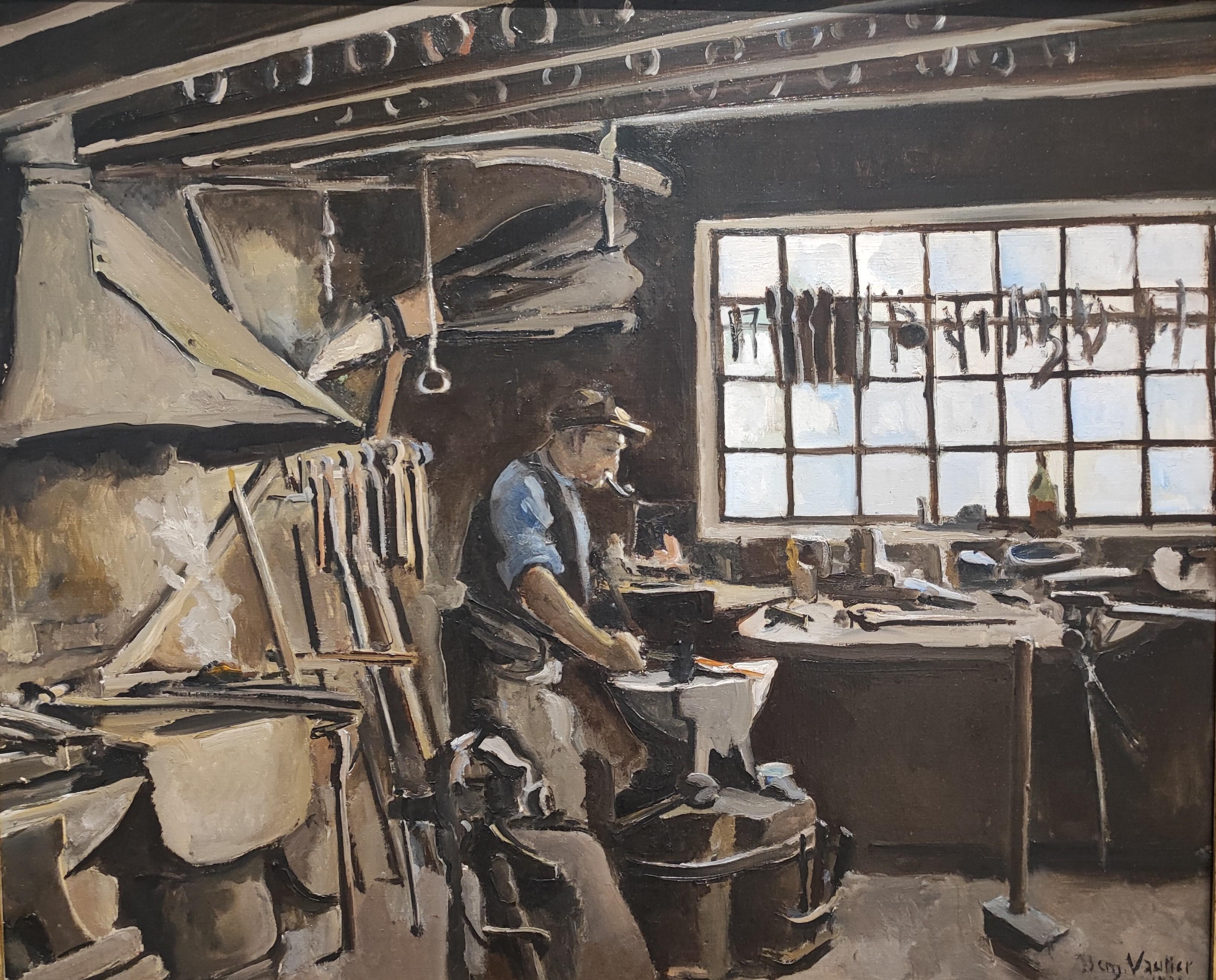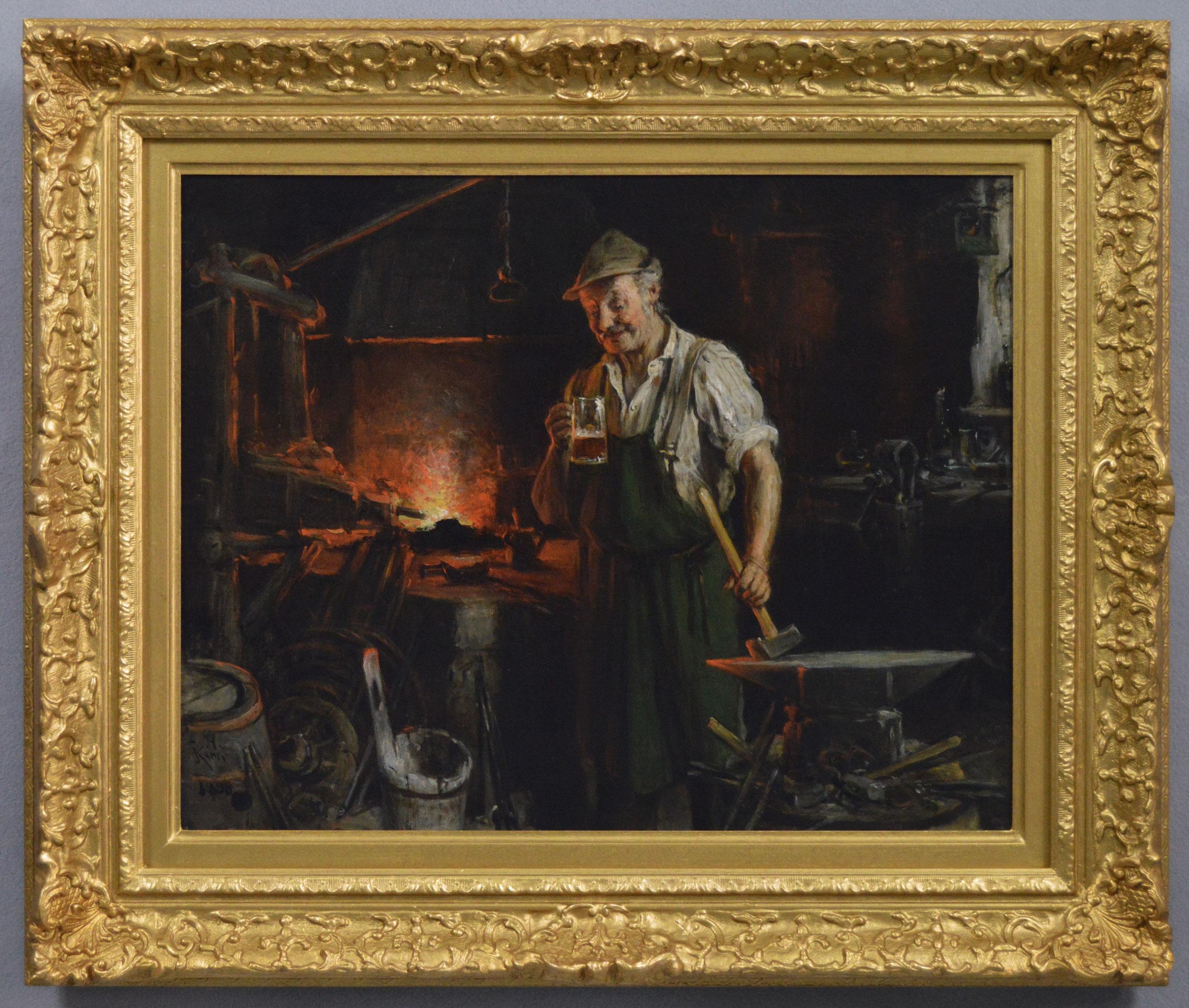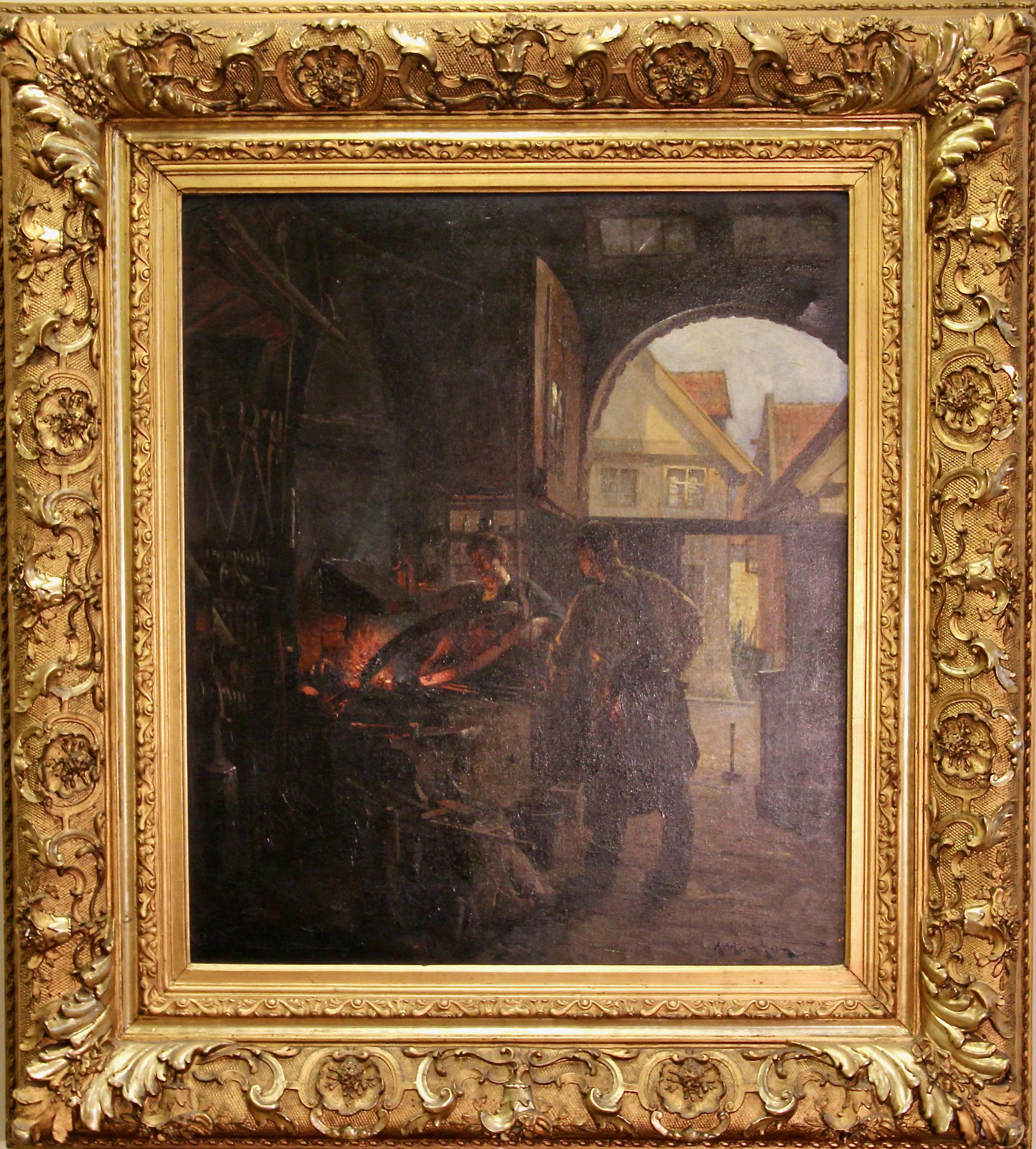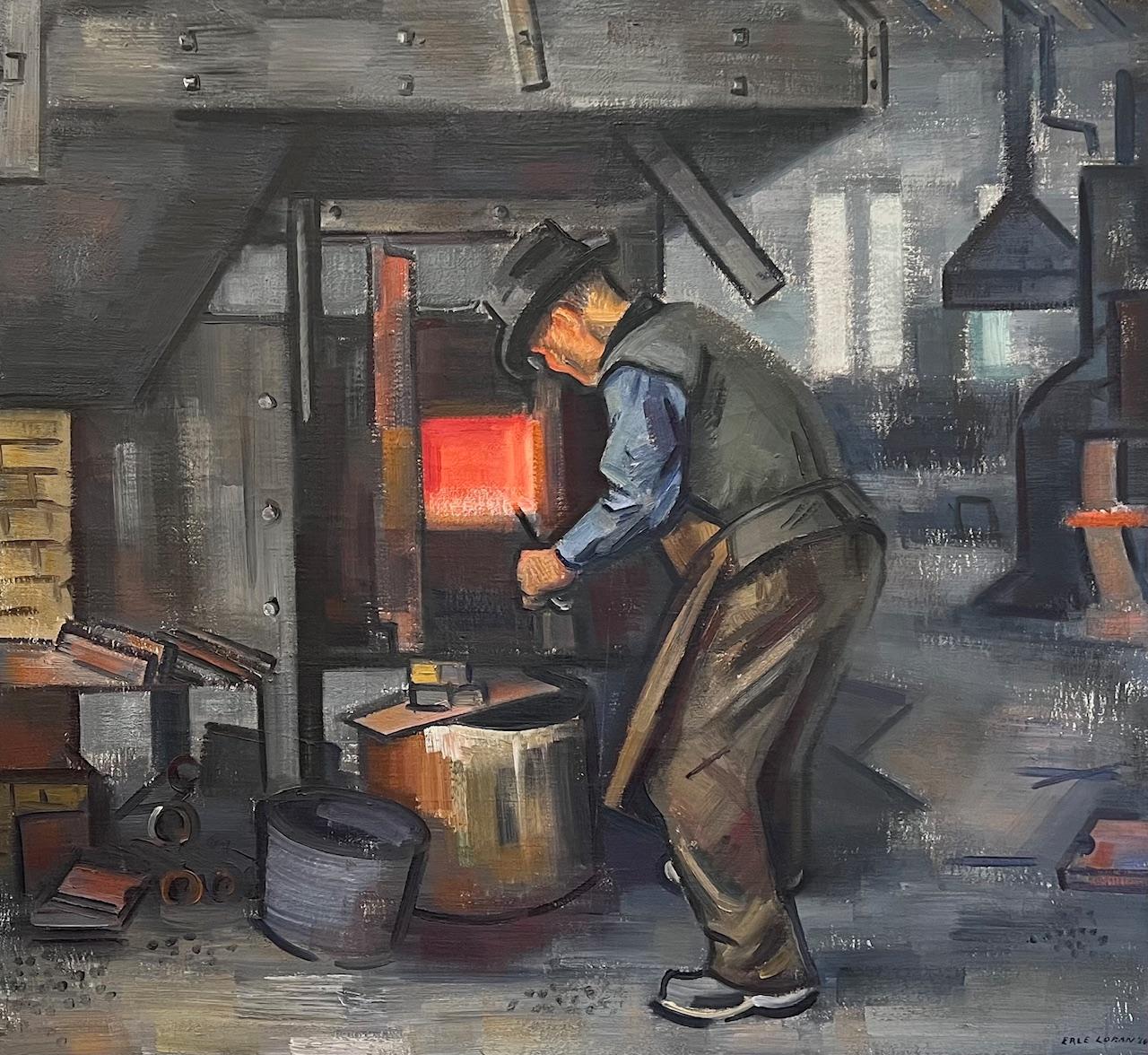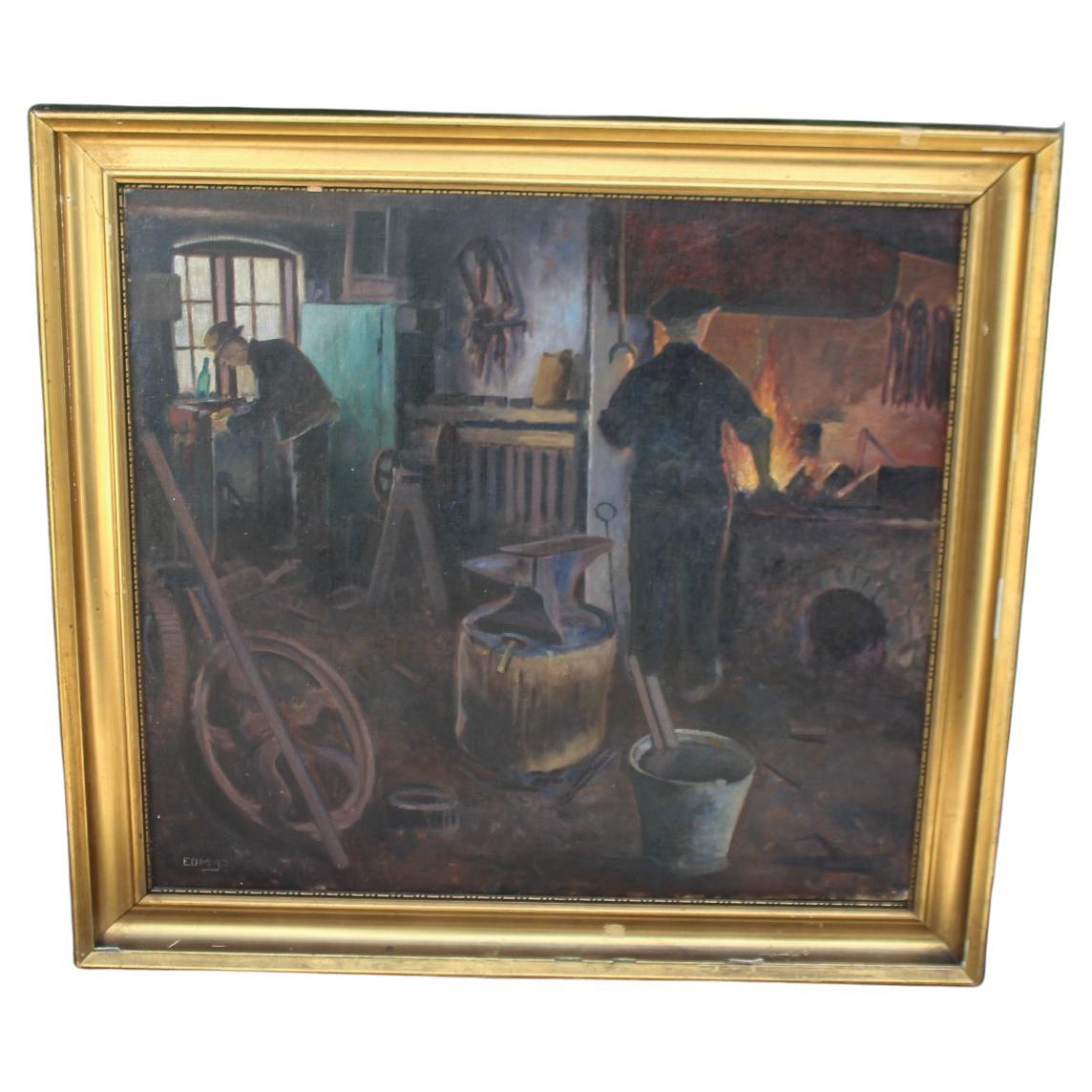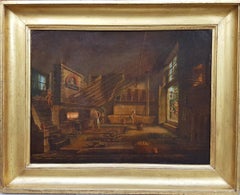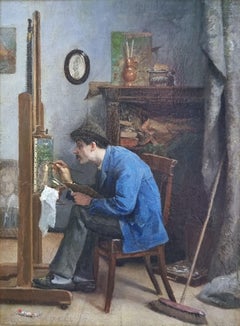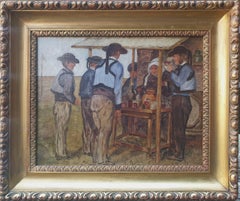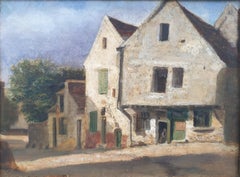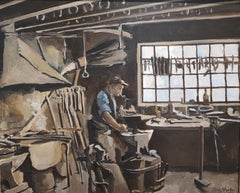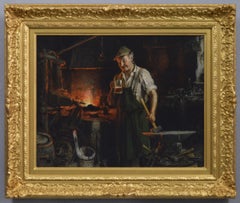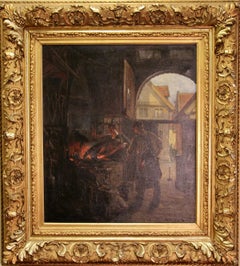Items Similar to French Realist Painting Black smith workshop Old trade Early 20th
Want more images or videos?
Request additional images or videos from the seller
1 of 8
Albert LEBARQUEFrench Realist Painting Black smith workshop Old trade Early 20th1912
1912
$832.71
£616.89
€700
CA$1,145.34
A$1,273.95
CHF 668.31
MX$15,545.11
NOK 8,388.18
SEK 7,904.84
DKK 5,329.71
About the Item
Albert Léon LEBARQUE
Quatre-Champs (Ardennes), 1853 – Paris, 1939
The blacksmith's workshop
Oil on panel24 x 18 cm (34.5 x 28 cm with frame)
Signed and dated lower left “A. Lebarque / 1912”
Beautiful painted wooden frame from the early 20th century
Very good condition
Painter, sculptor and medalist Albert Lebarque lived in Aulnay-sous-Bois. He studied with Eugène Carriere and is known for his painted ceramics. Painter and sculptor, Lebarque is known in particular for having designed the medals for the Compagnie du Chemin de Fer du Nord. Aulnay sous Bois is linked to the history of the French railway industry. The Paris-Soissons line was the vector of railway development linking Paris to the north of France. In 1875, the Bondy Railway Company was created in Aulnay-les-Bondy, which would later become Aulnay-sous-Bois. In 1898, the Northern Railway Company began studying a direct link from Aulnay-sous-Bois to Verberie in order to open a simplified route for freight trains between the industrial basin of the North and Paris. In 1911, the Company for the Construction of Railway Equipment, known as "La Lilloise," was founded in Aulnay-sous-Bois. It specialized in the manufacture of steam locomotives for narrow gauges and employed more than two hundred people in its forging, boilermaking, and machine tool workshops. Lebarque exhibited at the Paris Salon from the 1880s onward and at the Universal Exhibitions. He exhibited at the Salons of 1880 a "Portrait of Mr. L ...", in 1885 a "Medallion", in 1888 a "Head of an oriental woman, earthenware" and in 1889 a genre scene entitled "In the spotlight". Labarque received a medal of honor at the Salon of 1914 and a bronze medal in 1920 for two medal engravings.
This small painting signed by Albert Lebarque is close to the style of his master Eugène Carrière with a very beautiful light and nice colors. The subject is a ancient trade, that of blacksmith which developed in particular in Aulnay-sous-Bois in the 1910s with the creation of the workshop "la Lilloise". It is dated 1912.
- Creator:Albert LEBARQUE (1853 - 1939, French)
- Creation Year:1912
- Dimensions:Height: 9.45 in (24 cm)Width: 7.09 in (18 cm)
- More Editions & Sizes:34,5 x 28 cm with the framePrice: $833
- Medium:
- Movement & Style:
- Period:
- Condition:
- Gallery Location:PARIS, FR
- Reference Number:1stDibs: LU2524216143862
About the Seller
5.0
Gold Seller
Premium sellers maintaining a 4.3+ rating and 24-hour response times
Established in 2010
1stDibs seller since 2023
22 sales on 1stDibs
Typical response time: 4 hours
- ShippingRetrieving quote...Shipping from: PARIS, France
- Return Policy
Authenticity Guarantee
In the unlikely event there’s an issue with an item’s authenticity, contact us within 1 year for a full refund. DetailsMoney-Back Guarantee
If your item is not as described, is damaged in transit, or does not arrive, contact us within 7 days for a full refund. Details24-Hour Cancellation
You have a 24-hour grace period in which to reconsider your purchase, with no questions asked.Vetted Professional Sellers
Our world-class sellers must adhere to strict standards for service and quality, maintaining the integrity of our listings.Price-Match Guarantee
If you find that a seller listed the same item for a lower price elsewhere, we’ll match it.Trusted Global Delivery
Our best-in-class carrier network provides specialized shipping options worldwide, including custom delivery.More From This Seller
View AllPainting french school romantic 19th century oil on canvas Interior of a bakery
Located in PARIS, FR
French school of the first half of the 19th century Oil on canvas 45.5 x 60 cm (59.5 x 74 cm with frame) Beautiful 19th century carved and gilded wooden frame Good condition (a few r...
Category
19th Century Romantic Interior Paintings
Materials
Oil
$2,379 Sale Price
20% Off
RINGEL Belgian painting Realist school Workshop Painter 19th
Located in PARIS, FR
Frédéric RINGEL
Barmen (Germany), 1826 – 1907
The Painter in his Studio
Oil on canvas
33 x 24 cm (60 x 51.5 cm with frame)
Signed on the lower right side "F. Ringel"
Very fine 19th-c...
Category
19th Century Realist Interior Paintings
Materials
Oil
French school 1920s Brittany Brittons Village fair Pont-Aven Cornouaille
Located in PARIS, FR
J. BREYNAT (XXth century)
Oil on cardboard
20 x 30 cm (28 x 38 cm with the frame)
Signed and dated lower left "J. Breynat / 1921"
Beautiful carved wooden frame from the 19th century
...
Category
1920s Realist Figurative Paintings
Materials
Oil
Pierre Edouard FRERE Vue maisons Montfort L'Amaury Yvelines Impressionnist 19th
By Pierre Edouard Frere
Located in PARIS, FR
Pierre Edouard FRERE
Paris, 1819 - Ecouen, 1886
Oil on paper on canvas Signed lower left "Ed. Fr"
24.5 x 33 cm (32 x 39 cm with the frame)
Beautiful 19th century frame with canes and...
Category
1870s Impressionist Landscape Paintings
Materials
Oil
French Painting MARTIN-KAVEL Britanny Bretons Card playing Salon Paris 19th
By François Martin-Kavel
Located in PARIS, FR
François MARTIN-KAVELParis, 1861 – 1931The Card GameOil on canvas51 x 62 cm (68 x 78.5 cm with frame)Signed lower left and dated lower right “Martin-Kavel / 1885”Beautiful early 20th...
Category
1880s Academic Interior Paintings
Materials
Oil
Realist french painting Fishermen wifes BILLET portrait costumes 19th
Located in PARIS, FR
Pierre BILLET
Cantin (North), 1837 – Cantin, 1922
Oil on canvas
38.5 x 28.5 cm (48 x 36.5 cm with frame)
Signed lower left “Pierre Billet”
Stamp of the c...
Category
1880s Realist Figurative Paintings
Materials
Oil
$2,664 Sale Price
43% Off
You May Also Like
The blacksmith in his workshop
By Benjamin II Vautier
Located in Genève, GE
Work on canvas
Golden wooden frame
75 x 88.5 x 4 cm
Category
1930s Modern Interior Paintings
Materials
Oil
19th Century genre oil painting of a blacksmith at a forge
Located in Nr Broadway, Worcestershire
Hermann Armin Kern
Hungarian (1839-1912)
The Blacksmith
Oil on canvas, signed & dated 1898, with wax seal to reverse
Image size: 16 inches x 20.25 inches
Size including frame: 23.5 ...
Category
Late 19th Century Victorian Figurative Paintings
Materials
Oil, Canvas
Oil Painting by Anders Montan, "In the Forge, Smithery, Blacksmith" 19th Century
Located in Berlin, DE
Very decorative oil painting by Anders Montan, in the forge, 19th century
Signed lower right. Famous Swedish artist.
Dimensions with frame: 104 cm x 11...
Category
19th Century Figurative Paintings
Materials
Canvas, Oil
$9,040 Sale Price
20% Off
Marechal Ferrant (The Blacksmith)
By Hermine David
Located in New York, NY
Hermine David (1886-1970), Marechal Ferrant (The Blacksmith), etching and drypoint, signed in pencil lower right [also signed in the plate lower left], ...
Category
1920s Modern Figurative Prints
Materials
Drypoint, Etching
Blacksmith (Untitled)
By Erle Loran
Located in Los Angeles, CA
Blacksmith (Untitled), 1936, oil on canvas, signed and dated lower right, 28 x 30 inches
Erle Loran was an influential American painter, art historian, and educator, renowned for h...
Category
1930s American Modern Figurative Paintings
Materials
Canvas, Oil
19th century Danish BlackSmiths Forge by Edvard Petersen
Located in Seaford, GB
Atmospheric Blacksmith Forge Interior by Edvard Petersen signed by monogram
This magnificent late 19th-century painting of an atmospheric blacksmith forge interior is by the renowned realist Danish painter Edvard Petersen. Depicting a richly detailed industrial workshop scene, it is a remarkable example of Danish realism. As an authentic Edvard Petersen painting, it showcases the artist’s dedication to portraying the lives of craftsmen and workers in the late 1800s.
If you are an art collector or enthusiast seeking to purchase an original blacksmith interior artwork, this vintage realism painting not only holds artistic value but also represents an essential piece of Danish heritage art. Below, we explore the painting’s intricate details, its historical context, and Edvard Petersen's life.
1. Artwork Overview: A Glimpse into the Industrial Past
This vintage painting of a blacksmith’s forge reflects the hardworking spirit of the late 19th century. The atmospheric industrial art is meticulously rendered with a keen eye for lighting, texture, and realism. Key aspects of this Danish blacksmith workshop artwork include:
Industrial Setting: The painting captures the interior of a blacksmith workshop, filled with well-used tools and the dim glow of the forge.
Lighting Mastery: The late 19th-century atmospheric blacksmith interior is defined by its masterful use of light and shadow. The forge fire creates a vivid, warm glow, contrasting with the cooler daylight filtering through a window.
Human Element: The blacksmith figures appear in dynamic postures, emphasising the laborious nature of their craft. The workers’ silhouettes against the glow of the fire add depth and dimension.
Textural Details: The texture of worn wood, metal tools, and stone flooring is painstakingly realistic, typical of Edvard Petersen’s style.
2. Artistic Style and Techniques
A. Realism and Atmosphere
As a prominent Danish realist painting, this work exemplifies the realist tradition for which Petersen is known. His choice of subdued, earthy tones highlights the authentic industrial atmosphere. The blend of warm, fiery hues with darker, shadowy tones creates a dramatic and contemplative mood.
B. Composition and Structure
The composition follows a well-organised structure, with:
Foreground Elements: Anvil, tools, and a large wooden barrel.
Middle Ground: Figures working at the forge and a workbench.
Background: The illuminated workshop window and hanging tools.
Colour Palette: Predominantly browns, greys, and ochres with contrasting fiery highlights.
Lighting Effect: The combination of natural and artificial lighting enhances the sense of depth and space.
3. Significance of the Painting
A. Cultural Context
This late 19th-century blacksmith painting...
Category
Antique 1890s Danish High Victorian Paintings
Materials
Canvas, Paint
$1,211 Sale Price
20% Off
More Ways To Browse
Antique Trade Signs
French Railway
France Railway
Medallion Paintings
Blacksmith Painting
Blacksmith Sign
Antique Painting Tools
Albert Link
Steam Train
Antique Industrial Machines
Antique Industrial Tools
Steam Locomotives
Antique Blacksmith Signs
Antique Engraving Machine
Steam Train Painting
Antique Locomotives
Freight Train
Eugene Carriere
